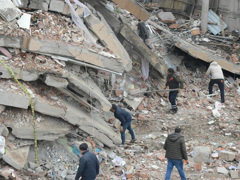News code: ---
| Published date: 2/10/2023 4:59:59 PM
| News subject: Incidents related to the building
In Turkey and Syria, outdated building methods all but assured disaster from a quake
Scenes of thousands of buildings reduced to rubble in southern Turkey and northern Syria following Monday's deadly magnitude 7.8 earthquake — and its many aftershocks — come as no surprise to civil engineer Jonathan Stewart.
"We've seen this before," says Stewart, an engineering professor at the University of California, Los Angeles who was part of an infrastructure assessment team dispatched to Turkey after a major quake struck the north of the country in 1999.
At the time, he says, "there was tremendous loss of life from pancaked buildings."
Earthquake death toll tops 7,700 in Turkey and Syria as race for survivors continues
MIDDLE EAST
Rescuers work for second day to find quake survivors as death toll surpasses 5,000
Fast-forward to Monday, and video of the destruction shows exactly this "pancaking" — the sudden collapse of a multi-story building as bystanders flee for their lives.
The region is one of the most earthquake-prone in the world, as it lies in an area where three tectonic plates meet. In addition to the 1999 quake that left more than 17,000 people dead, Turkey also experienced a major quake in 2011 that killed hundreds.
This time around, the death toll already exceeds 5,400 in Turkey, with 1,800 more dead in neighboring Syria, where the infrastructure was already crumpling after years of civil war.
Sponsor Message
Here's what we know about what caused the Turkey earthquake
SCIENCE
Here's what we know about what caused the Turkey earthquake
In both countries, survivors may be under the rubble, but more bodies too — maybe many more — are likely to be found in the coming days under the debris left by an estimated 3,000 structures destroyed by the quake, according to a preliminary estimate by Turkish officials.
Older buildings fell apart quickly when the shaking began
Why did so many buildings fall down? Stewart says that for buildings in Turkey that are more than about three stories tall, a usual construction technique is to use reinforced concrete.
"Typically, the columns and the beams are concrete," he says. "And then there's kind of a masonry infill block inside these frames, which falls apart very quickly when the shaking begins."
Abbie Liel, an engineer and professor at the University of Colorado Boulder, says that assessment pretty much matches what she's seen in photos of the destruction in Turkey.
Rescuers search for victims and survivors in the rubble of a collapsed building in Aleppo, Syria, on Monday.
AFP via Getty Images
Instead of this type of brittle construction, she says, engineering a building to withstand earthquakes means factoring in an "ability to deform."
"That involves putting a lot of rebar in all the right places," she says.
Kit Miyamoto, an expert in disaster resiliency engineering who is preparing to head to Turkey as part of a team of engineers, says building codes enacted after the 1999 quake near Izmit are good, but a lot of structures predate those codes.
Photos: Searches continue after deadly quake in Turkey and Syria
THE PICTURE SHOW
Photos: Searches continue after deadly quake in Turkey and Syria
"Anything built prior to 2000 can be considered very dangerous," he says. Further, even with the newer building codes, enforcement is "not very robust," so even some of the latest construction is not necessarily up to standards.
"Quality control in the field really matters," he says.
More steel equals more-quake-resistant structures
The amount of steel and the types of concrete in a building can make the difference between structures still standing in the earthquake zone and those that lie in ruins, says Alanna Simpson, a senior disaster risk management specialist at the World Bank based in Bucharest.
Sponsor Message
"Buildings made of steel would actually respond quite well in earthquakes because they're a little bit flexible," she says. "So the more steel reinforcement in a building, the better it's likely to respond."
No, you can't predict earthquakes, the USGS says
WORLD
No, you can't predict earthquakes, the USGS says
She says the building codes in Turkey were updated again in 2018. But the country's "legacy buildings" are still vulnerable, and that goes for much of the rest of the world, too, she says. "It's a global problem."
It's also important to note that Monday's quake was so large and shallow that "in almost any part of the world [where] a similar earthquake would happen, you would see substantial damage to older buildings," Simpson says.
As for building back safer buildings, "it takes much longer than anybody would hope to reconstruct after such a big tragedy," she says. "It's expensive and it needs a lot of coordination and public outreach."

